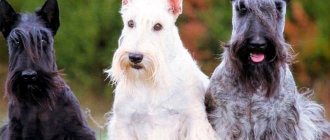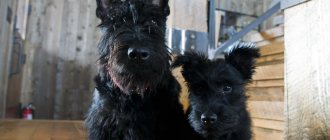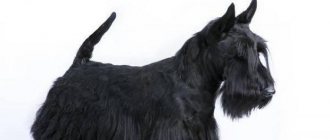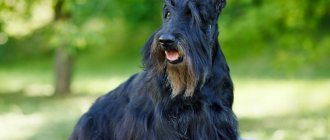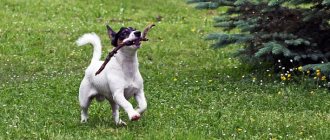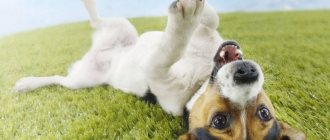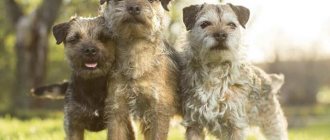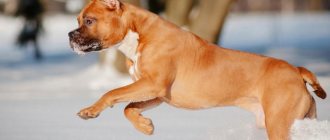The appearance of the Scotch Terrier makes you smile tenderly. Little bearded men are captivating with their appearance and character, they are “on their own” and know how to stand one step above their owner, which many people like. Life with a Scottish Terrier is a constant struggle for leadership, keeping both the owner and his pet in good shape.
Breed characteristics
| Short description | |
| Origin: | Scotland |
| Conditions of detention: | Apartment, house |
| Purpose: | Hunter dog, companion dog, show dog |
| Color: | Tiger, black, wheat |
| Wool length: | Long |
| Adult dog size: | Height – 25-28 cm, weight – 8.5-10.5 kg |
| Average life expectancy: | 12-13 years old |
| Walk: | Need two walks a day |
| Physical activity needs: | Average physical activity needs (1-1.5 walks per day) |
| Fédération Cynologique Internationale (FIC) classification: | Group 3: Terriers; Section 2: small terriers |
| Puppy price: | From 10,000 to 60,000 rubles. Without pedigree - 10,000 rubles, pet class - up to 15,000 rubles, breed class - 30,000-40,000 rubles, show class - up to 60,000 rubles |
Grooming
In terms of maintenance, Scottish Terriers are excellent for city life. They do not need to be constantly bathed and combed, and the small size of the pet will “fit” even into a small apartment. The only caveat is the coat, which requires shearing and regular trimming.
The hard coat perfectly protects it from heat, cold, moisture and dirt, but without mechanical assistance it hardly sheds.
Old fur that has lost its elasticity and shine is plucked by hand. Scotch tape is trimmed once every 3-6 months. The frequency depends on the age, nutrition and characteristics of the individual dog. This procedure is carried out for the first time at the age of six months, ideally under the guidance of a groomer or breeder.
When it comes to a show Scottish Terrier, you cannot do without the services of an experienced groomer. But a “home” hygienic haircut is much easier to do - the hair is cut so that the pet is not bothered by the excess length.
The hair on the head, cheekbones, neck and throat is shortened with a clipper or scissors. To give a concentrated look, long “eyebrows” and a “beard” are left so that the hair does not interfere with the dog’s vision. The hair is removed briefly along the back of the nose (a “parting” is obtained) and on the ears, giving them a pointed shape towards the tips.
To make the Scottish Terrier look neat, the coat is shortened on the back and sides, under the tail and on the shoulders (on the side, starting from the base of the ears and down, with a smoothly widening wedge). You can insert a picture here. 2, the main sections are shown there. The lower part of the fur on the belly, body and paws forms a long skirt: at the owner’s request, from a few centimeters to a “floor-length skirt”.
We remind you that this is a haircut for home use only. Exhibition grooming of a Scottish Terrier is complex due to dozens of nuances, from the thickness and length of the coat in certain areas to compliance with the standard (it is necessary to hide shortcomings and emphasize advantages without going beyond it).
History of the origin of the species
Officially, Scotties come from Scotland and are believed to be one of the very first terriers bred. They were bred in the mountainous northern regions of the country to protect warehouses and houses from small rodents. The name is directly related to the country of origin: “Scottish”
Terriers were supposed to hunt burrowing animals and rats. In the conditions of constant wars for independence and financial instability, the dogs’ appearance was not monitored, and the conditions for their physical condition were harsh.
Although the first representatives can be seen on canvases of the 16th century, they differ significantly from modern specimens: semi-erect ears, an overly long body and coarse hair. Since the end of the 18th century, breeders began working on the external parameters of dogs. First of all, the saber-shaped tail was corrected, now it is a short sausage to make it easier for hunters to get pets out of holes.
The first standard was written in 1879. Since this time the breed has spread throughout Great Britain. Dogs are depicted on stamps and labels of alcoholic beverages. They are described in books and put on in circus acts.
Interesting Facts
The Scottish Scotch Terrier attracts its fans due to its funny appearance and “British” character. Not surprisingly, many unusual facts are known about this dog:
- The Scottish terrier was kept by 2 US presidents - T. Roosevelt and D. Eisenhower.
- The terrier was the companion of the brilliant physicist A. Einstein.
- This cute dog has repeatedly attracted the attention of writers. Thus, the Scottish terrier became the hero of R. Kipling’s book “Your Faithful Dog Boots.” This adventure story about 2 dogs has been translated into several languages, including Russian.
- Of course, the Scotch Terrier also became the hero of films. Fans of old cinema will probably remember that in the Soviet TV series “The Adventures of Sherlock Holmes,” a black Scottish terrier was the favorite companion of Inspector Lestrade, played by Bronislav Brondukov. True, the screen dog, according to the script, died suddenly due to the fact that the unlucky policeman confused the medicine with poison.
- The legendary clown Pencil often performed acts with the participation of his assistant Scotch, nicknamed Blob. Few people know that in fact her role was played by 17 similar understudies.
- The Scotch Terrier also became the “face” of Scotch whiskey under the Black&White brand.
This is interesting! The dogs earned the affectionate name “Scotty” long ago, when they were best friends for hunters, and now this nickname is also in use.
Distinctive features
Scotties have strict exhibition parameters, so compliance with standards must be almost one hundred percent.
The ratio of body length and height is considered mandatory. The dog is definitely elongated; square and short bodies are considered a defect.
The height of the pets does not exceed 28 cm, and their weight is 10 kg.
In general, Scottish Terriers are short, strong animals, with well-built limbs and muscular structure, smooth long hair and an original appearance. Despite their size, they are in good physical shape. The Scots are agile and can develop great speed.
- The head is long, narrow, square, flat between the ears. The stop is weakly expressed.
- The muzzle is long (equal to the skull). The bridge of the nose is straight, the cheekbones are flat. The jaw is wide with large teeth. Scissor bite
- The nose is large, slightly sloping back, black.
- The eyes are set deep under the eyebrows and wide. The shape is almond, medium size, always dark brown.
- The ears are small, set high and not wide. The fabric is thin. Pointed in shape.
- The body is elongated and strong. The topline is horizontal. The back is short. The loin is wide and powerful. The chest is well rounded and dropped. The neck is short but muscular.
- The tail is short, thick at the base. Set high and vertical, held towards the top. May be slightly rounded.
- The limbs are straight and short, strong. The paws are dense with collected toes (the hind legs are slightly larger than the front ones). Movements are smooth.
- The coat is wiry, long, and harsh; the undercoat is soft and short.
- Colors: wheaten, black, brindle.
Nutrition
There are no special features in feeding Scottish terriers. We can only separately emphasize their tendency to allergic reactions. Dry food for these dogs should be:
- premium class;
- hypoallergenic;
- balanced and contain all essential microelements.
If the owner prefers natural food, then the weekly diet should contain:
- lean meats and fish;
- cereals;
- vegetables;
- dairy products.
Premium dry dog food
Rating
Holistic dog food
Rating
Small breed dog food
Rating
Photo of an adult dog
Photos of puppies
Features of character and behavior
Dogs can be called true aristocrats: they are smart, restrained, phlegmatic and calm. On the other hand, owners note frequent mood changes. At one moment, the pet can become playful, active and cheerful or irritable and nervous. Like all terriers, Scotch loves to chew, dig, and bark.
These pets are stubborn and wayward. They value freedom and personal space and rarely impose their company. A real fighter lives inside a small dog: Scotties are able to protect property and notify the owner of danger. In their homeland they are called “those standing to die.”
Advantages
The advantages of the breed include:
- Unobtrusiveness (these pets know when to approach the owner, they will not bother);
- Calmness and balance (most often pets are phlegmatic);
- Good mental abilities, high learning ability, observation skills;
- Restraint towards other dogs, often even friendliness;
- Courage, pronounced protective instinct;
- Good physical qualities (the hunting instinct is strongly expressed, so the working qualities of the pets are still preserved);
- Lack of expressed aggression.
Flaws
Proper education of a dog is the key to good behavior and adequacy. However, in the case of Scotch tape, this does not quite work. They are indeed very changeable in mood, so it is difficult to control them. Common breed disadvantages include:
- Changeability in mood;
- Wariness towards strangers;
- Dislike of cats and small rodents;
- Intolerant of children and their pranks (subject to equality and understanding, Scotch can be friends with a child, although such dogs are not suitable for children);
- Stubbornness, willfulness, leadership.
Care and maintenance
Scotchies are apartment pets . They are not suitable for outdoor use, but this does not mean that they will be against a country house with an adjacent yard area. Their fur protects the skin from mechanical damage and repels dirt, so bathing dogs does not cause much trouble. In cold and dirty weather they are dressed in protective overalls.
The main problem is frequent and long walks. Despite their size, Terriers need active walks: the more, the better. Therefore, when buying a puppy, you need to be prepared for the fact that you will have to walk with your pet for 1.5-2 hours twice a day.
Before purchasing Scotch tape, it is important to take care of its place in the house. You need to purchase a comfortable soft lounger and place it near the master’s bed. In addition, the pet needs bowls on stands, toys, and hygiene products.
Dogs' teeth are brushed every week with a special paste or cord. Nails are trimmed monthly if they are not worn off on the asphalt. The eyes are inspected for the presence of discharge and wiped as they become dirty. The ears are plucked of hairs (inner shell) and cleaned of wax.
Nutrition
These dogs are not picky about their diet, but must receive a full range of vitamins and minerals for harmonious development. A good option would be super-premium food for small breeds, which already contains all the necessary substances.
But experienced dog breeders trust natural food more, although it causes a lot of trouble. Your dog's diet must contain proteins:
- By-products;
- Meat;
- Eggs;
- Fermented milk products;
- Sea fish.
In addition, your pet needs carbohydrates, which he can get from cereals, vegetables and fruits.
It is forbidden to feed your pet human food: give it bones, fatty and fried foods, flour and sweets. Legumes, potatoes, and millet will not be beneficial. It is not recommended to mix natural and dry foods or suddenly switch from one to the other.
Adult Scotties are fed 2 times a day. Puppies up to 3 months - 5 times , up to six months - 3 times . In general, a pet needs 300-400 grams of food per day. The serving size depends on the activity of the pet and the time of year (in summer the serving size is reduced).
It is important to maintain a drinking regime and take bottles of water for walks. The drinking bowl should always be full.
We recommend that you read a detailed article on the topic: “How and what to feed a dog: types and characteristics of nutrition.”
Health
Scottish Terriers cannot be called weak dogs. They are hardy, have good immunity and good health. On average, pets live 12-13 years . Hereditary diseases usually appear in old age.
To protect your pet from unwanted viral infections, it is important to carry out a course of vaccination and show the dog to the veterinarian at least once a year. Much also depends on nutrition and compliance with the rules of caring for the animal.
Vaccinations
Vaccination of hunting dogs is one of the main points in maintaining strong immunity. It is from wild animals that pets most often get viral diseases that are practically incurable or leave serious complications.
Vaccination does not provide a 100% guarantee of protection, but it does help the puppy recover from an illness. Unvaccinated pets do not tolerate infection well and die. Even if the pet does not hunt, vaccination is mandatory, because bacteria and viruses are carried on household items.
The most important course of vaccination is carried out in the first year of a puppy’s life. The first vaccination is done in the nursery. A veterinary passport is also issued there. The breeder will tell the future owner about the medications and dates of the procedure. The owner should follow the schedule for further vaccinations.
Vaccinations against common infections (mumps, enteritis, influenza, distemper, etc.) are carried out at 2, 2.5, 6 and 12 months. When the mother's immunity weakens, the puppy is especially vulnerable to infection, so walking him before the second procedure is strictly prohibited. The vaccination should be repeated annually in the same month.
The second important vaccination is against rabies. It is done at 7 months and repeated annually because the effect of the drug weakens. Without these vaccinations, your pet cannot be transported across the border. 20 days before transportation, the dog must be examined by a veterinarian, receive a health certificate and check the stamps in the veterinary passport. The procedures must have been carried out within the last 12 months .
Important article on the topic: “Everything you need to know about dog vaccinations.”
For vaccination to be successful, you need to follow several rules:
- 2 weeks before the procedure, pets are dewormed; on the day of the injection, their temperature is measured (weak and sick animals are not allowed);
- After each vaccination you must undergo quarantine (14 days);
- Vaccination is carried out by veterinarians in special clinics to help the pet in case of an allergic reaction;
- All procedures are included in the puppy’s veterinary passport;
- If you observe side effects that last longer than a day (nausea, vomiting, frustration, tremors, lack of appetite, drowsiness), you should consult a doctor.
The cost of vaccination varies from 400 to 1000 rubles. It depends on the weight of the pet and the tax of the veterinary clinic.
Diseases
Diseases characteristic of the breed:
- Deafness;
- Poor blood clotting;
- Bladder cancer;
- Atopy (allergic diseases);
- Cataract;
- Demodicosis (skin disease caused by mites);
- Benign skin tumor;
- Cramps.
Walk
Scotties are outdoor enthusiasts. They will be happy to run around outside and meet new animals. Although they would rather take the side of the observer than the active doer, they enjoy being among their fellow humans. Adult pets are walked 2 times a day for 1.5-2 hours. Dogs need to release their pent-up energy.
Small puppies are gradually accustomed to the street.
- In the first 2-3 days of walking, you can simply carry Scotch in your arms 2-3 times a day.
- Later they put a leash on him and walk him 3-4 times for 30 minutes.
- After a couple of weeks, you can transfer the puppy to walking twice a day, gradually increasing the walking time.
You should not let your pet off the leash until he learns to follow basic commands.
Although these pets do not need intensive training, active games will not hurt. Terriers enjoy chasing balls, frisbees, and participating in various dog sports, such as agility.
It is important to properly socialize your puppy. To do this, from childhood he is introduced to other people and animals, and is gradually accustomed to noisy places: train stations, highways, public transport. Terriers can bark and lunge at people; this is a natural habit, but you can get rid of it with proper training.
Grooming
The coat of dogs requires careful care.
- Firstly, pets are bathed monthly using special zoological shampoos for coarse fur, and then blow-dried.
- Secondly, they are brushed with a long-toothed brush 2-3 times a week.
- Thirdly, pets need trimming (hair plucking) 2 times a year during molting (or before the exhibition).
The groomer also trims the “skirt” (fur on the belly and sides), bangs and beard.
After each meal, Scotch needs to wipe his beard with a damp cloth, and after walks, wash his paws and “skirt”.
During the warmer months, flea and tick treatment is important. Deworming is carried out every two months with the help of medications.
Scottish Terrier Health
An important advantage of the breed is endurance and unpretentiousness. The four-legged “Scots” practically do not get sick. The only hereditary disease that may appear in some individuals is seizures. It is rare and only occurs during active recreation. Pets with this disorder should not be physically stressed.
If you decide to buy a Scotch Terrier from a breeder or pet store, it is very important that the puppy is tested for von Willibrands disease (VWD). This is a genetic disease of the jaw. It is the most common disease in Scotch Terriers.
Also keep in mind that Scottish Terriers are sometimes prone to allergies. Therefore, you need to choose a balanced diet for them. It is forbidden to give small bones, sweets, dishes made from semolina, white flour and rolled oats. The food should not contain a lot of protein, because with a sedentary lifestyle the animal can become fat.
Every little hunter needs active games. The ideal option would be walks away from noisy companies. In addition, the dog can participate in short distance runs.
Mating
In a year, a male can fertilize about 40 females, but it is recommended to give birth no more often than once every 2 years, especially since the breed is characterized by difficult births. Pets begin to knit at 20-25 months, although they reach sexual maturity at 8-10 months. The main criterion is the bitch’s readiness to bear offspring. The best time for conception is considered to be 13-15 days of the third mating. At this time, signs of readiness appear: a loose loop, light discharge, playful behavior.
If the pets are breeding, they are bred through the nursery. There, the owners fill out forms and find a suitable candidate. Animals must complement each other's shortcomings with their advantages. The owners agree on the date and price.
On the appointed day, the female is brought to the male. Animals are small and do not require much space. But due to their specific constitution, pets need help. For the first time, you should invite a specialist.
The dogs are given 10-15 minutes to get to know each other. If the female allows the cage to be mounted, half the job is done. Otherwise, you can try the next day or find another candidate. Sexual intercourse takes from 10 to 20 minutes. If there is no lock, it is better to repeat the mating after 48 hours.
Read a detailed article on the topic: “Everything you need to know about breeding dogs: appropriate age, what to do if it doesn’t work out, rules and tips.”
Estrus in Scottish Terriers
Puberty in dogs occurs much earlier than the formation of the body necessary for the reproduction of full-fledged offspring is completed.
Females usually reach sexual maturity at 6-8 months of age, males at 12-16 months of age. At this time, animals experience a desire to copulate and are prone to masturbation.
Dogs, especially females in heat, must be carefully monitored to prevent early and unwanted mating.
Real physical development in females occurs only at the age of 18-24 months, in males at the age of 24 months . For breeding dogs of all breeds, use females aged from 18 months (in third heat) to 8-9 years, males - from 2 to 10 years.
Key points in training
Scotch cats are stubborn, but have good mental potential; they can often be found in the circus arena or in street shows. They learn easily if they are attached to their owner and listen to him. Therefore, the first point of training is education.
The owner needs to prove his leadership, show firmness and perseverance.
You can’t beat or humiliate your pet. Scotties feel all the intonations of their voice, so they easily pick up on the mood and quickly understand where they did something wrong.
- Training begins with a puppy of 2 months. They teach him simple rules of behavior: don’t jump on beds, don’t beg, etc. After establishing a reliable connection with a person, the Terrier will obey and follow commands, but will require encouragement.
- From 4 months , when the pet learns its name, you can begin to learn the basic commands: near, not allowed, place, voice, quiet.
Read about how to properly train a dog in the article: “Training a puppy: effective methods from dog handlers, learning commands at home.”
If you plan to raise a dog for hunting purposes, then it must be raised by trained people.
Additional Information
As has been mentioned many times in the article, the Scottish Terrier is a very proud and willful dog. He is distrustful of strangers and will most likely choose only one owner for himself. It should be noted that the Scottie is also a very jealous dog, so it is difficult for him to share his person with other pets, and his hunting instincts make it impossible to be close to rodents, birds and other small animals.
If the family already has a cat or other pet, it is worth introducing the animals gradually and constantly monitoring the dog’s behavior. Without proper education and attention, an unpleasant situation can occur. It is not recommended to let your Scottish Terrier go without a leash. Due to its strong hunting instinct, the dog may strangle the neighbor's cat or other small animals. Training must be taken very seriously and started from a very early age, because later it will be impossible to re-educate an adult dog.
